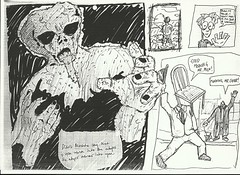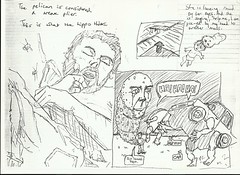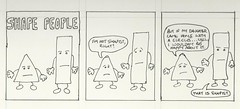Hello you.
Welcome to the sixth edition of Comics are Magic (click link for the archives). This is just a short one because its been a while. It concerns the magical influence of classic Silver Age story The Flash Stakes His Life On You! from The Flash#54 by way of two modern magicians and comics creators.
The first, Alejandro Jodorowsky is probably best known for his films, the alchemical allegories El Topo, The Holy Mountain and Santa Sangre. For those unfamiliar with his work here’s the trailer for his masterpiece The Holy Mountain. That’s subjective of course, and they are all stunning, mind-warping films, but The Holy Mountain is I think clearest in its alchemical intent.
Jodorowsky started out as in theatre, co-founding the Panic Movement in 1962 which drew on Antoin Artaud’s Theatre of Cruelty and staged violent and surreal performance pieces. From wikipedia:
The movement’s violent theatrical events were designed to be shocking,[2] and to release destructive energies in search of peace and beauty. One four-hour performance known as Sacramental Melodrama was staged in May 1965 at the Paris Festival of Free Expression. The “happening” starred Jodorowsky dressed in motorcyclist leather and featured him slitting the throats of two geese, taping two snakes to his chest and having himself stripped and whipped. Other scenes included “naked women covered in honey, a crucified chicken, the staged murder of a rabbi, a giant vagina, the throwing of live turtles into the audience, and canned apricots.”
In his excellent memoir The Spiritual Journey of Alejandro Jodorowsky he describes how he moved to Mexico to undergo initiation with a number of female shamans. Like Alan Moore, Jodorowsky views art and magic as inseparable. He later combined theatre, magic and psychotherapy in his practice of psychomagic where the patient’s personality and family tree are studied to come up with symbolic performances to be acted out, based on the principle that the unconscious mind accepts symbolic acts as fact. Here is one example of many from his book on the subject (page 132):
A young Chantal, at four years old, found herself placed in a school directed by the sister of the mother of her mother…The great-aunt sadistically tyrannized the child. In working with me, Chantal discovered all the hate she held towards to this woman. She could not forgive her, and she had no way to avenge her because the torturer was no longer in this world. So I advised her to go to the grave of this woman and, once there, give free rein to this hate: that she kick, scream, piss, and defecate on the tomb, but provided that she dedicate herself to paying close attention to her subsequent reactions to her demonstrations of vengeance. She followed my advice, and after letting off some steam atop the sepulcher, she felt a deep desire to clean it up and cover it with flowers. And, little by little, she couldn’t help but surrender to the evidence that she, in fact, felt love for her great-aunt.
A true polymath, Jodorowsky has also developed his own reconstruction of the Tarot of Marseilles, which he summarises in the video below:
Jodorowsky has worked regularly in the comics medium. His earliest comics work included the strip Fabulas Panicas, which debuted in 1967 (and ran to 1973) in the Mexican newspaper El Heraldo de México. Below is one of these strips. There are many, many more over at fabulaspanicas.blogspot.co.uk, dedicated entirely to reproducing the strip and well worth your time. Even if like me you don’t speak Spanish.







